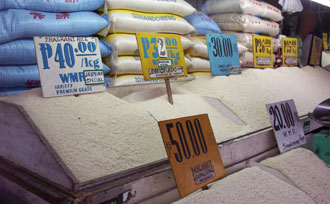BY RONALYN V. OLEA
Bulatlat
For this year, the Arroyo government would import 2.296 million metric tons (MT) of rice.
Based on the estimated NFA stock inventory as of July 1 this year, 929,337 MT are imported rice, accounting for 97.99 percent of the NFA stock.
The NFA targets to import 971,145 MT of rice from July to December. Meanwhile, the planned local palay (rice grain) procurement during the same period is only 51,238 MT.
Fines Cosico, NFA grains operations officer, said the NFA normally imports about ten percent of the country’s annual rice requirement and and imported rice supposedly constitutes only three percent of its buffer stock.
More expensive
In a primer titled “100% Rice Self-Sufficiency and Self-Reliance Equals Genuine Food Security,” the NFA Employees Association (NFA-EA) stated that from 1968 to 2008, the price of wholesale imported rice per MT was more expensive than domestic rice for 21 years out of the 48-year period.
In January this year, the price of imported rice per MT was US$409 or P16,769. It rose to US$1,091 per MT or P44,731 in April. The landed cost of imported rice is estimated at P67,096 ($1,604 at the April exchange rate of $1=P41.82) per MT during the same period. The landed cost takes into account freight cost, insurance, tariff, equalization fee, among others.
Meanwhile, the wholesale price of local rice in April is P30,000 ($717) per MT or less than half the landed cost of imported rice.

Even private traders are not interested in importing rice due to the high cost.
Losses
The NFA-EA also said, “Rice importation has greatly contributed to the NFA’s losses especially with the imposition of the rice import tariff.”
From 2002 to 2006, the NFA paid more than P20 billion ($389,787,565 at the 2006 average exchange rate of $1=P51.31) to the Bureau of Customs – Department of Finance. The tariff on rice was pegged at 50 percent.
On top of this tariff, the NFA also spends for transport, handling, stevedoring, and arraste services, warehousing, pest management, among others.
It is only in 2007 when the Arroyo government exempted the NFA from paying tariff on rice imports.
WTO commitment
Why does the government insist on importing rice?
Even the Department of Finance (DoF) said that losses of the NFA may reach P43.1 billion ($925,786,703 at the September 19 exchange rate of $1=P46.555) if the price of rice in the world market increases to more than US$1,000 per MT.

Cosico said the Arroyo government’s rice importation program is in compliance with its commitment to the World Trade Organization (WTO). Under the WTO’s minimum access volume (MAV), the country is obliged to import a certain volume of rice whether or not there is a supply shortage.
Cosico said the Arroyo government seems to be telling them to buy imported rice at any cost. On the other hand, local procurement remains very low.
Local procurement
The NFA buys local palay at low prices.
The NFA-EA revealed that from February 1999 to October 14, 2007, the NFA bought palay at only P10 ($0.216 at the 2007 average exchange rate of $1=P46.148) per kilogram even as the actual farmgate price then reached P11.21 ($0.24).
Since October 15, 2008, the price of palay increased by P1.50 ($0.03) per kilogram.




